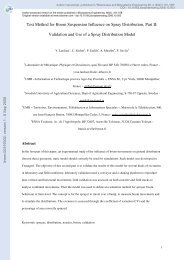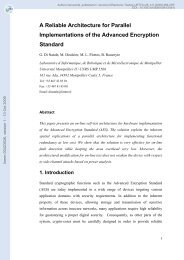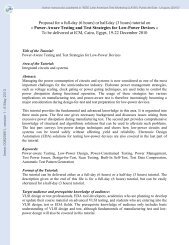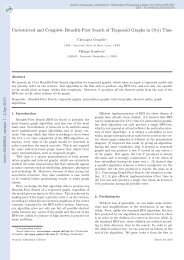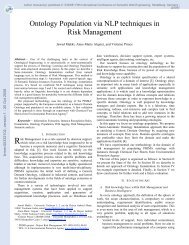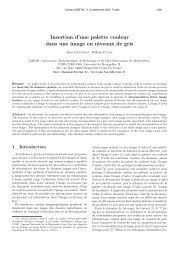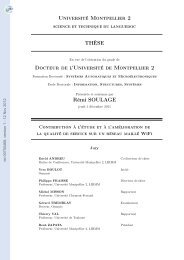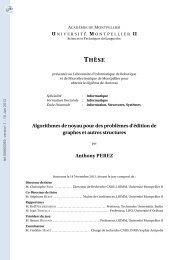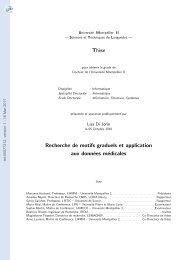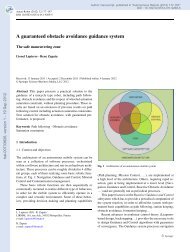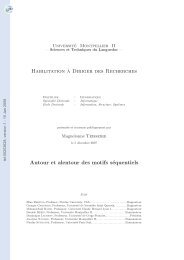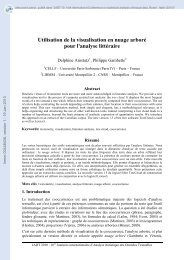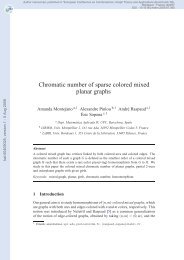FMA & HMTP Portal in OWL - HAL - LIRMM - CNRS
FMA & HMTP Portal in OWL - HAL - LIRMM - CNRS
FMA & HMTP Portal in OWL - HAL - LIRMM - CNRS
You also want an ePaper? Increase the reach of your titles
YUMPU automatically turns print PDFs into web optimized ePapers that Google loves.
anatomical lobe that are a regional_part_of some lung. A particular process is def<strong>in</strong>ed<br />
for A_of_B where A is Region, Zone, Segment, Subdivision. From<br />
<strong>FMA</strong> authors, all ‘region’ classes of the <strong>FMA</strong> denote regional parts, further<br />
dist<strong>in</strong>guished on the types of boundary used to def<strong>in</strong>e the region, for example Organ<br />
segment is an organ region with one or more anchored fiat boundaries, Organ zone is<br />
an organ region with one or more float<strong>in</strong>g fiat boundaries. At the moment, the p<br />
handled are only the part_of properties and subproperties (e.g.;<br />
regional_part_of) but this will next be extended to other relationships.<br />
(b) Axioms. The lexical patterns are not only used for class def<strong>in</strong>itions, but also for<br />
handl<strong>in</strong>g - creat<strong>in</strong>g/remov<strong>in</strong>g/mov<strong>in</strong>g - axioms:<br />
• Disjo<strong>in</strong>tness and subclass axioms. While the sibl<strong>in</strong>g symetrization process provides<br />
semantics to classes of pattern P_A, it operates other tasks at the same time: 1° it adds<br />
relevant subclass axioms. 2° it detects and repairs errors or omission <strong>in</strong> the native<br />
<strong>FMA</strong> (for details see Algorithm 1). For example, while the mean<strong>in</strong>g of Left_Hand<br />
is formalized by the equivalent class axiom (3) meanwhile, several subclassOf<br />
axioms are added: for example axiom (6) asserts that each hand necessary has exactly<br />
one left or right laterality and the axiom Disjo<strong>in</strong>tClasses(Left Right),<br />
states that noth<strong>in</strong>g can be both left and right. In fact, for each modality, only one<br />
s<strong>in</strong>gle disjo<strong>in</strong>tness axiom is created to state that noth<strong>in</strong>g can have two opposite<br />
modalities. Hence, all Left_A and Right_A, e.g.; left and right hands are <strong>in</strong>ferred<br />
to be exclusive, and much less axioms are used. The algorithms implemented for each<br />
pattern are quickly sketched below.<br />
Algorithm 1. The process for symmetrical sibl<strong>in</strong>gs first parses all names of classes to<br />
get the terms match<strong>in</strong>g a specific prefix P_ where P is a subclass of<br />
Primary_Anatomical_coord<strong>in</strong>ate (e.g. Left). For each class P_A, (e.g.<br />
Left_A/Right_A), if A exists and A (or Anatomical_A) is a direct superclass<br />
of P_A, then several axioms are created respectively for P_A, its sibl<strong>in</strong>g and its<br />
father, accord<strong>in</strong>g to the follow<strong>in</strong>g rules: (1.1) each time A has a child P_A, A should<br />
have the pair as children, unless exceptions; (1.2) each time A has two symmetrical<br />
children, e.g.; Left_A and Right_A, and A has an existential restriction on a part<br />
property or subproperty, the two sibl<strong>in</strong>gs should have symmetrical restrictions<br />
(modulo symmetry); (1.3) if a (symmetrical) restriction is present <strong>in</strong> two symmetrical<br />
sibl<strong>in</strong>gs but not <strong>in</strong> their direct superclass, the relevant abstracted restriction is added to<br />
it. For example, as Left_Hand and Right_Hand have restrictions<br />
ObjectSomeValuesFrom(:constitutional_part: Invest<strong>in</strong>g+fascia+of+left+hand)<br />
(resp. Invest<strong>in</strong>g+fascia+of+right+hand), the miss<strong>in</strong>g axiom subclassOf(<br />
Hand ObjectSomeValuesFrom(:constitutional_part:Invest<strong>in</strong>g+fascia+of+<br />
+hand)) is created; (1.4) as expla<strong>in</strong>ed above, for each P_A, two axioms are created:<br />
a class axiom EquivalentClasses(:P_A ObjectIntersectionOf(:P :A)) and<br />
a subclassOf axiom like (6) for example, which asserts that each A necessary has<br />
exactly one left or right laterality SubClassOf(:A ObjectExactCard<strong>in</strong>ality(1<br />
:laterality ObjectOneOf(:<strong>in</strong>dividual_Left :<strong>in</strong>dividual_Right))).<br />
Algorithm 2. Similarly, the process first parses all names of classes to get the terms<br />
that match the pattern A_of_B. The EquivalentClasses(:A_of_B<br />
ObjectIntersectionOf(:A ObjectSomeValuesFrom(:p_of :B))) axiom is created <strong>in</strong> any<br />
7



